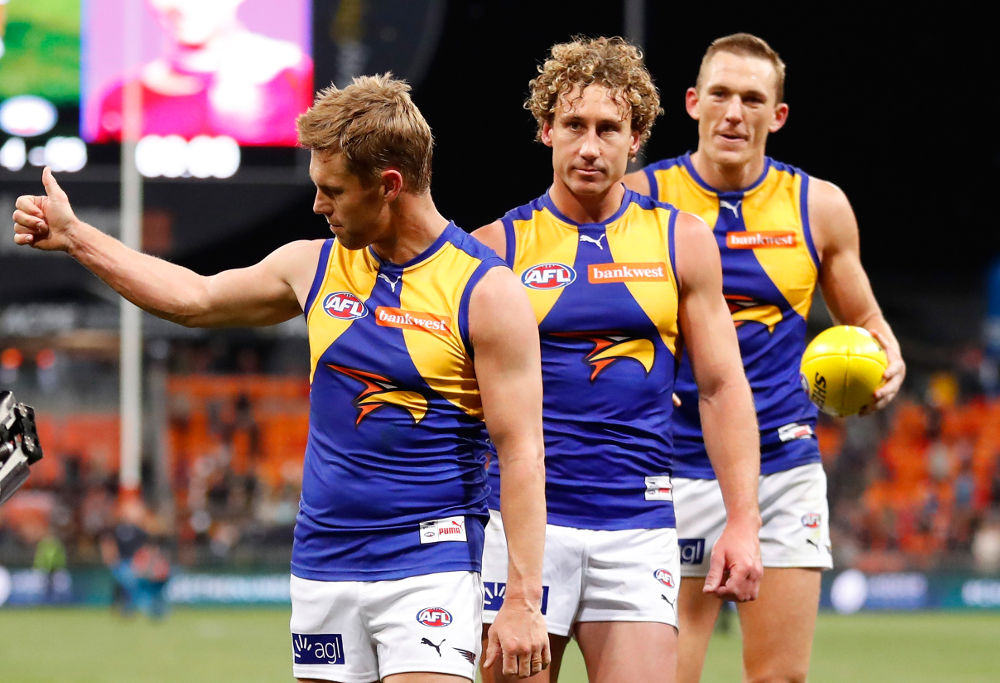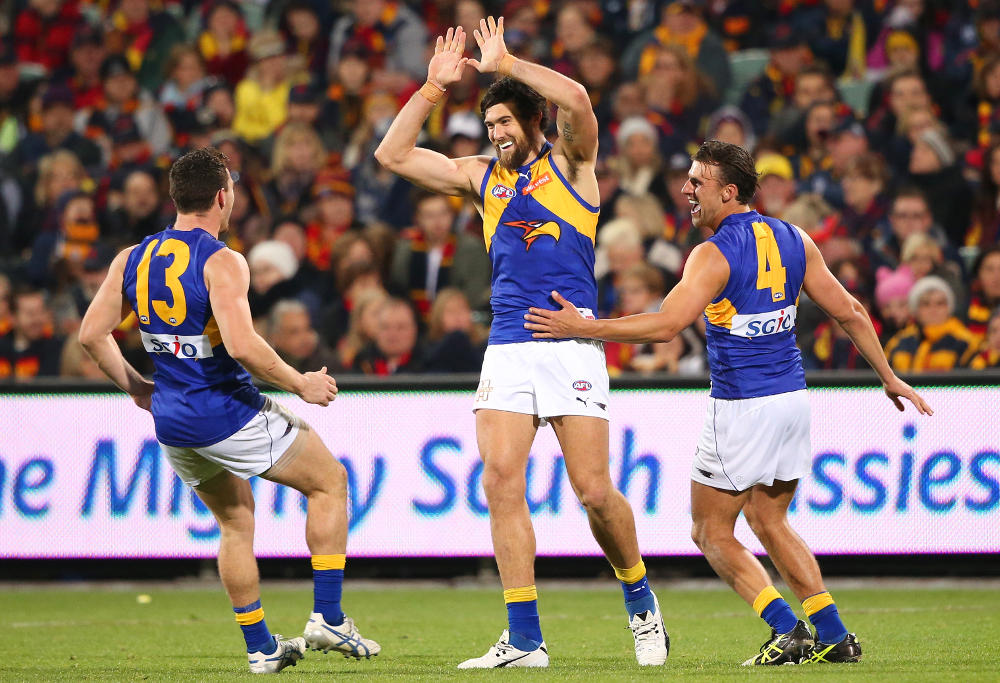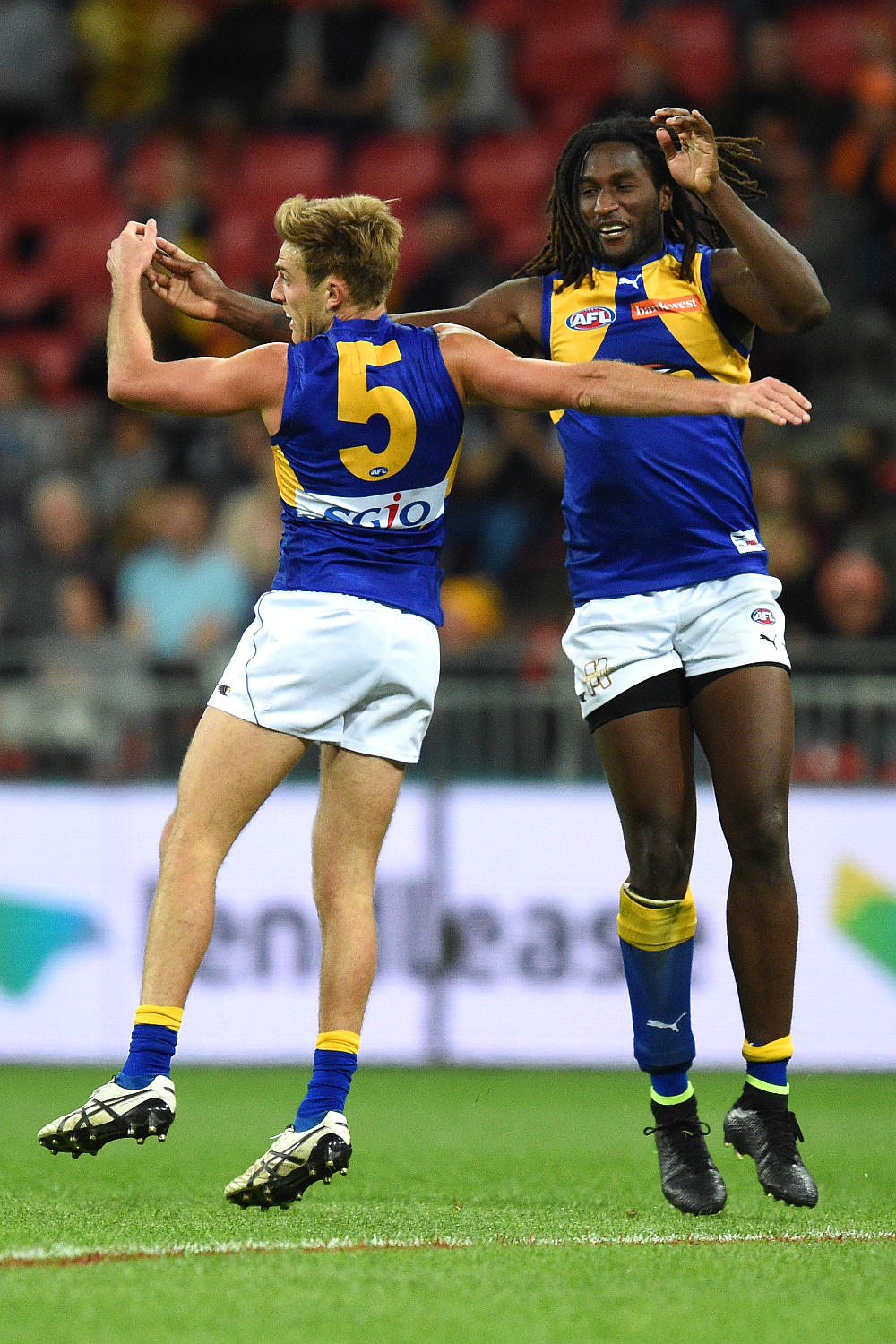A premiership contender or bottom-four candidate? All options are on the table for the West Coast Eagles.
No one does the yo-yo rebuild like West Coast. In the past decade and a bit, the Eagles:
- Lost a premiership (2005)
- Won a premiership (2006)
- Finished second last (2008)
- Finished 11th (2009)
- Won a wooden spoon (2010)
- Made the top four (2011)
- Finished 13th (2013)
- Finished ninth (2014)
- Lost a premiership (2015)
- Finished eighth (2017)
The first crash was driven by cultural factors rather than footballing destiny – West Coast had the 12th oldest list in 2007 – and the incentives of the old priority-pick system.
More recently, it was the burn-out of John Worsfold, and a caveman gameplan that amounted to not much more than the advice of every fan over the age of 60: just kick the bloody thing.
Adam Simpson took the reins in 2014, and against expectations brought the team within a win of eighth place (Richmond won its last game by three points to hang on to the last finals seed). Matt Priddis won the Brownlow medal that year, too.
The 2015 season was full of expectation, until key defenders Mitch Brown and Eric Mackenzie both suffered ruptured ACLs and were ruled out for the year. It spurred the creation of the ‘Weagles Web’ (still number one on the list of terrible names given to tactics by the football media), the man-zone scheme that turned West Coast into a counterpunching tour de force.
It carried the club to a grand final, Simpson becoming the first former Alastair Clarkson assistant to win a final against his mentor in the process.
West Coast was a premiership favourite in 2016, finishing sixth on 16 wins after sputtering away from home. The most significant event of the year was undoubtedly Nic Naitanui’s late-season knee injury, his four-centimetre-long ACL becoming one of Western Australia’s go-to talking points.
As the 2017 season seemed to escape the club, they abruptly changed course. The Eagles shed an enormous volume of experience, both in raw terms and as far as actual games played goes.
This preseason? Who the hell knows. History suggests, from eighth spot, West Coast could yo-yo back up the ladder or crash down to the depths.
[latest_videos_strip category=”afl” name=”AFL”]
Turnover in the right places
After loading up in the 2016 offseason, West Coast have gone about a list cull that gets close North Melbourne’s of a year prior.
The Eagles dropped 930 games worth of AFL experience between September and November 2017, where the Kangaroos lost 1406 over the same period in 2016. While it was around 500 fewer games, the Roos’ chainsaw massacre was unprecedented in modern times.
North chopped six experienced players, and let Daniel Wells walk in free agency. West Coast also removed six experienced players, and if you want to count Jonathon Giles (four AFL clubs probably counts as experience, regardless of actual games played) then we hit the magic seven.
North Melbourne’s changes had more immediate impact to the structure of its team, too. Of the 506 games their players played in 2016, the Kangas lost the players that played 135 of them – or more than a quarter. Like the raw experience lost, that is an extraordinary number: the average in a given year across the league seems to be 11 per cent. West Coast dropped 19 per cent of 2017 games played (98 out of 528), lower than North but still more than average. By way of contrast, Sydney retained all but four of their 2017 games played.
Then there is the stature, or tenure, of the players. 930 games is a lot, but 661 of them were to the credit of Sam Mitchell and Drew Petrie, who spent one year and a combined 38 games at West Coast. Both are now part of the off-field crew. Contrast that again with the losses at North – Petrie, but also Brent Harvey, Michael Firrito, Daniel Wells, even Nick Dal Santo – and it is clear this is a different situation.
One may argue it is turnover in the right places. West Coast was a slow team playing in a league that increasingly demanded pace – on the ground, in the air, and of the mind. The Eagles retained their aerial advantage for much of 2017 (recording a +2.4 differential in contested marks per game, third in the league), but were exposed with regularity when the ball hit the deck.
In stark contrast to their aerial prowess, West Coast was smacked around to the tune of -9.5 per game in adjusted contested possession differential (a refresher: contested possessions less free kicks and contested marks – it’s a proxy for ground balls), ranked second last in the league behind the babies of Brisbane. The club laid just 63 tackles per 50 minutes of opposition possession, ranked 14th, and ultimately ended the year with a negative inside 50 differential of -3.4 per game for the first time in Simpson’s tenure.
So, the club decided Mitchell’s future was in the coaches’ box, and the Brownlow Medallist declined his second playing-year option. Petrie was always a one-year rental, but fits the slow archetype.
Priddis, who signed an extension during the year, about-faced and left the club a hero. Sam Butler and Sharrod Wellingham, half back flankers in the club’s 2015 grand final team, were not offered contracts. Josh Hill, who averaged 3.8 groundballs and 2.5 tackles a game, was delisted.
Some at-risk veterans survived, perhaps out of a want to avoid a total shock to the system – and a need to delve deep into the darkest regions of the national draft. Mark LeCras’ spot in the team was increasingly tenuous as the year progressed. Chris Masten lost his.
The sum total is 930 games of experience lost. But West Coast could be richer for the changes.

Photo by Michael Willson/AFL Media/Getty Images
Functional forwards
The Eagles’ back six is all-but sorted. All Australian Jeremy McGovern is the rock at centre half back, while Tom Barrass takes the big full forwards where they still exist at full back. Brad Sheppard and Shannon Hurn are the mid-sized participants. Elliot Yeo made the half back/defensive midfielder position his own last season, earning an All Australian spot in the process.
The club still needs to work out whether Jackson Nelson is the answer to their pace-and-space question, or whether the three-tall look involving Eric Mackenzie or Will Schofield (a dasher himself) is the go. The former won’t be available until the early stage of the year, however.
It’s also possible that Yeo is called upon to take up more of the core midfield load following the retirements of Mitchell and Priddis. Here too, West Coast have options. Jack Redden has an opportunity to become the number two behind Luke Shuey, but on the form of his first few years out west one would think that’s an outside chance.
Instead, it is likely Simpson will turn the keys over to his younger brigade.
Dom Sheed and Liam Duggan have shown bundles of potential, with injury and raw disposal the pairs limiting factors so far. The club’s first pick in the 2016 draft, Daniel Venables, reportedly has the guts and girth to play in the slop, but at 19 years of age coming into the season won’t be the saviour. The Eagles also traded in local Brendon Ah Chee from Port Adelaide with the intent of rolling him through the middle.
These are sizeable changes to an important unit. However, the club can surely sink no lower than second to last on the ground even with a bit of friction.
Where West Coast really needs a shake up is forward of the ball. The club has the best traditional key forward in the game in Josh Kennedy, but otherwise, all five starting spots should be – and reportedly are – up for debate. And it’s not clear they have the right personnel mix in this area of the ground.
Last year’s mid-sized and small forward unit was a debacle, giving none of the attributes demanded of the position in 2017. The Eagles have two men set to shoulder the load: 2016 draftee Willie Rioli and 2017 draftee Liam Ryan. Rioli missed all of last season with hamstring injuries and general fitness issues, as Ryan carved up the WAFL on his way to a 73 goal haul for the year.
Both are fast on the ground, and have a keen sense for goal on the hop and in the set piece. AFL Media reported this week the duo have shown an insatiable appetite for the tougher stuff required inside the stripe – an outstanding sign, as Simpson’s side were weak here last season.
Jack Darling gets the centre half forward spot almost by default, and despite the hilarity of the process at times generally puts together quality second tall forward seasons without much fuss. Whether he becomes a higher half forward option to give game time to Jarrod Brander – the first key forward picked in last year’s draft – remains to be seen, but one would assume he will see game time.
There are still plenty of gaps to fill at this end of the ground. However, Richmond and the Western Bulldogs have shown over the past few years that scheme can trump personnel in the forward half of the ground. That’s a stretch for Simpson, who didn’t have a lot in his bag of tricks when West Coast’s season slipped around the midway point last season.

AAP Image/Ben Macmahon
Return of the Nat
Nic Naitanui, the 2012 (wait, that’s it?!) All Australian ruckman, last played a competitive game of football on August 19, 2016.
In those 17 months, he’s undergone traditional ACL tear surgery, a specialist rehabilitation stint in the US, and a further arthroscopic clean up on his injured knee. He reportedly hasn’t begun jumping in the ruck.
At face value, a lack of genuine ruck work eight weeks out from the first bounce is a significant concern. Giving some latitude, it’s all just a part of the 19-month rehabilitation program Naitanui will have been on if he makes it back for Round 1.
Today, we will yield to optimism. Naitanui’s return is one of the most significant storylines the league.
At the peak of his powers, Naitanui can be the most devastating all-around ruckman in the competition. His centre bounce work is a signature Australian rules football play: the leap, the tap, the clean burst from congestion by a running midfielder, the kick piercing the chest of a tall forward on the lead.
Naitanui is a beast around the ground too, scrimmaging his own clearances at stoppages, ragdolling midfielders with impunity, and hoovering up groundballs. In 2015, he was the only player with more than 500 hitouts (the sign of a genuine ruckman before the third-man-up ban), more than three clearances, more than three tackles, and more than six groundball gets per game.

AAP Image/Dan Himbrechts
The Eagles recorded a clearance differential of -2.7 per game in the 26 games it played in Naitanui’s absence; in the 26 games prior, where Naitanui had played, that figure was +0.9 – still not much above the middle of the pack, but the gap is clear.
He is an enormous upgrade in the ruck position. Consider West Coast relied upon a ruck platoon made up of Nathan Vardy, Jonathon Giles and Drew Petrie in 2017; it’s like swapping baked beans for caviar. Whether both he and fellow injured big man Scott Lycett can be in the same team remains to be seen, but we should get some insight into this during West Coast’s preseason hit outs.
That’s because in the time since Naitanui left the game, there has been a significant change to how his position works: the third-man up is no more. We are yet to see how one of the most athletic ruckmen in the history of the game goes to work as a prime-age player with a clean run at the ball. It could be revolutionary.
Pragmatically though, is Naitanui going to be the same player he was before that fateful – club-altering – evening in 2016? It remains to be seen.
Which, quite aptly, is the theme likely to weave its way through the entirety of the Eagles’ season. With so many changes to their starting line up – some of which are yet to fully reveal themselves – they loom as this season’s biggest wildcard.
Add to this the new stadium, new training facilities, all-but-new coaching staff, and the Eagles’ yo-yo could go either way and it wouldn’t be a shock.
































































































